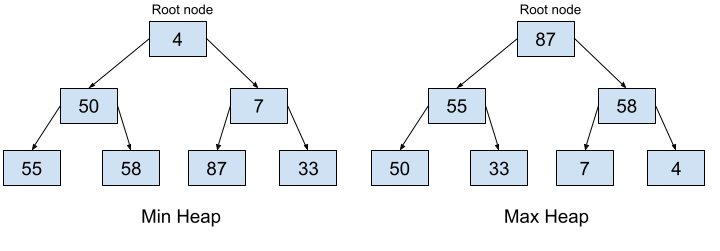In this article, we will learn about an important Data Structure, Heaps in Python (known as heap queue in Python). We will learn about the data structure and its implementation and then look at the Python code for the same.
What are Heaps in Python?
Heaps in Python are complete binary trees in which each node is either smaller than equal to or greater than equal to all its children (smaller or greater depending on whether it is a max-heap or a min-heap).
Hence the root node of a heap is either the smallest or the greatest element. The heap data structure is generally used to represent a priority queue.
Generally, Heaps are of two forms:
- Min-Heap: Min heap is the heap in which all nodes are lesser than their children. The root contains the lowest value in a min-heap.
- Max-Heap: Max heap is the heap in which all nodes are greater than their children. The root contains the highest value in a max-heap.
Following is the example for min heap and max heap.

Heaps in Python, by default, are Min-heaps, and further in this article, we will be considering min-heap when we talk about heap. Let us now see how the heap data structure is actually implemented.
How are heaps represented in Python?
The heap data structure is theoretically in the form of a binary tree, but due to its property of completeness (wherein the tree is complete except for the rightmost nodes in the last layer), the heap is stored in the form of an array in the memory. The first element contains the minimum element (in the case of min-heap).
The heap, which is in the form of a tree, is stored in the array, and its elements are indexed in the following manner:
- The root element will be at the 0th position of the array, that is, Heap[0].
- For any other node, say Heap[i], we have the following:
- The parent node is given by : Heap[(i -1) / 2].
- The left child node is given by : Heap[(2 * i) + 1]
- The right child node is given by : Heap[(2 * i) + 2]

Using the heapq module to implement heaps in Python
Python has the “heapq” module for the implementation of Heap Queue (or simply heap). It contains the functionality that the smallest element will always be at the top and will be popped when called the pop function.
Whenever elements are either pushed or popped, heap property will be maintained, and heap[0] will always give us the smallest function.
The module contains the following major functions for heap:
- heapify( iterable_name ): We use this function to pass any iterable (for example a list) and it converts it into a heap data structure.
- heappush( heap_name, element_to_be_inserted ): As the name suggests, this function pushes/ adds an element to the heap. We need to pass the heap name and element to be inserted as a parameter. The function takes care of rearranging the heap (if need be) to satisfy the heap property.
- heappop( heap_name ): As the name suggests, this function pops/removes an element from the heap passed as a parameter. The function takes care of rearranging the heap (if need be) to satisfy the heap property.
Practical Implementation of Python heaps
Now, we will implement a min-heap in Python. We use a list [15, 7, 9, 4, 13] in the code and convert it to a heap using the heapify function. The heap made would look like this:

Implementation of heaps in Python:
# The heap functionalities are in the heapq package, so import it
import heapq
# we now initialise a list to be converted to heap
lis = [15, 7, 9, 4, 13]
# converting lis to heap using the heapify function
heapq.heapify(lis)
print ("The heap looks like: ")
print(lis)
#using the heappop function
print ("The popped item using heappushpop() is : ",end="")
print (heapq.heappop(lis))
print ("After popping, the heap looks like: ")
print(lis)
#using the heappush function to push 2
print ("After pushing 2, the heap looks like: ")
heapq.heappush(lis, 2)
print(lis)
Output:
The heap looks like:
[4, 7, 9, 15, 13]
The popped item using heappop() is : 4
After popping, the heap looks like:
[7, 13, 9, 15]
After pushing 2, the heap looks like:
[2, 7, 9, 15, 13]
Here, we can see that the heapq package provides functionalities to create a queue, and push and pop elements to it. After pushing or popping, the heap automatically rearranges itself, as was seen in the output.
Conclusion
In this article, We learned the concept of heaps in Python. We studied what max-heaps and min-heaps in Python are, and how they are represented.
We further implemented it in python using heapify, heappush, and heappop functions. Stay tuned for more informative articles.
Happy Learning!
